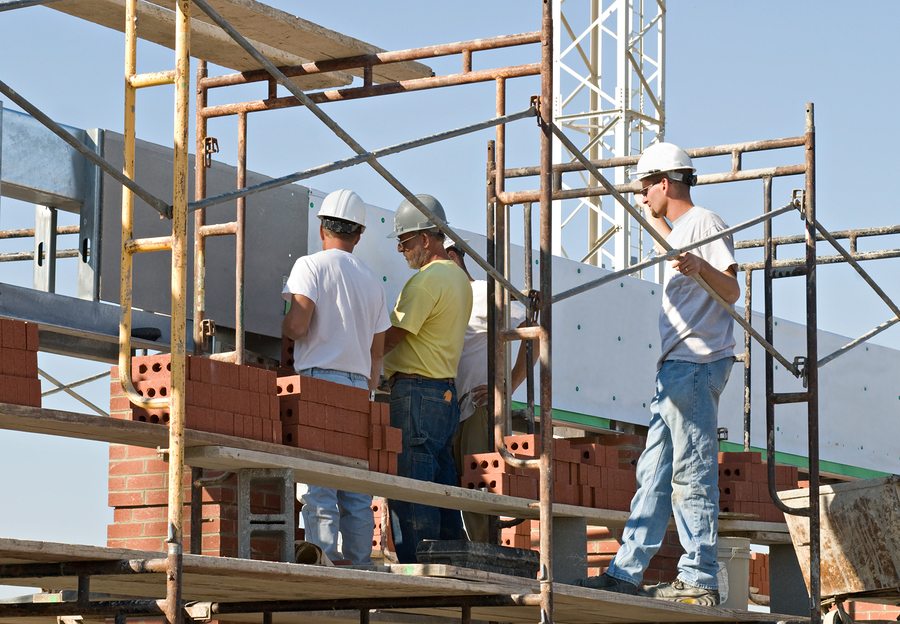by jeffp | Mar 8, 2017 | Construction
Abrasive blasting is an important method in construction to handle a number of tasks: Preparing a surface for paint, applying a texture, or for cleaning surfaces.
While a time-efficient method it comes with serious risks to worker safety.
One problem with abrasive blasting is that it is loud. OSHA says it can lead to “significant” hearing loss for individuals working with or near equipment. As a result, it is critical that employees use hearing protection. In addition, employers are required to have a well-defined hearing-loss prevention program.
Another issue is that materials used in the blasting process can create dust that is toxic to workers. Abrasive materials often include steel grit, glass grains or smashed glass, coal slag, or silica. Breathing in these materials can cause damage to the lungs and even lung cancer. Some materials contain traces of other harmful materials like cadmium, arsenic, and beryllium!
It’s critical that companies strive to keep their employees safe from these threats. It all starts with an appropriate risk assessment. Your insurance professional can be a great resource to help you understand risks and the resources you can leverage to understand dangers and protect your employees. You need to have a solid training program and you need to be sure that there’s strict adherence to all safety protocols.
Other mitigation suggestions include using barriers to separate areas being blasted. Also it is recommended to leverage less toxic blasting products and mixing with water to minimize dirt and dust. Alternatives also include using air systems to remove dust.
From a site management perspective, keeping air clean via either wet techniques or HEPA-filtered methods is important. It’s also critical to keep equipment clean. Additionally, it’s best to work on calm days as wind can pose problems.
OSHA also notes that workers should not drink or eat near locations that are being treated with abrasive blowing. It’s also recommended that workers are given access to separate locations for showering and changing so they can clean up quickly and easily and avoid bringing toxic materials home with them.
by jeffp | Mar 8, 2017 | Construction

Abrasive blasting is an important method in construction to handle a number of tasks: Preparing a surface for paint, applying a texture, or for cleaning surfaces.
While a time-efficient method it comes with serious risks to worker safety.
One problem with abrasive blasting is that it is loud. OSHA says it can lead to “significant” hearing loss for individuals working with or near equipment. As a result, it is critical that employees use hearing protection. In addition, employers are required to have a well-defined hearing-loss prevention program.
Another issue is that materials used in the blasting process can create dust that is toxic to workers. Abrasive materials often include steel grit, glass grains or smashed glass, coal slag, or silica. Breathing in these materials can cause damage to the lungs and even lung cancer. Some materials contain traces of other harmful materials like cadmium, arsenic, and beryllium!
It’s critical that companies strive to keep their employees safe from these threats. It all starts with an appropriate risk assessment. Your insurance professional can be a great resource to help you understand risks and the resources you can leverage to understand dangers and protect your employees. You need to have a solid training program and you need to be sure that there’s strict adherence to all safety protocols.
Other mitigation suggestions include using barriers to separate areas being blasted. Also it is recommended to leverage less toxic blasting products and mixing with water to minimize dirt and dust. Alternatives also include using air systems to remove dust.
From a site management perspective, keeping air clean via either wet techniques or HEPA-filtered methods is important. It’s also critical to keep equipment clean. Additionally, it’s best to work on calm days as wind can pose problems.
OSHA also notes that workers should not drink or eat near locations that are being treated with abrasive blowing. It’s also recommended that workers are given access to separate locations for showering and changing so they can clean up quickly and easily and avoid bringing toxic materials home with them.
by jeffp | Jan 6, 2017 | Construction

Ladders are a fundamental tool in construction. They are so commonplace it is easy to forget they are potentially hazardous. When it comes to ladders, it’s up to construction company owners and leaders to set the safety tone. It starts by insisting that proper safety rules are followed to reduce the risk of worker injury.
Think it’s no big deal? 81% of construction-related fall injuries treated in hospital emergency rooms involve a ladder! Falls are the #1 cause of death on construction sites. Ladders are involved in 33% of those fatalities. Yet ladder related injuries are easily prevented.
Many safety rules involve how a ladder is climbed. Running up a ladder at break-neck speed is, well, inviting a broken neck.
The American Ladder Institute says that the best way to climb a ladder is to always have 3 points of contact. Workers shouldn’t be carrying items in their hands that could get in the way of keeping a hold on the ladder. (Use towlines, an assistant, tool belt, etc. to deliver tools and materials instead.)
Other safety tips include:
- Go up the ladder slowly and carefully. The goal is to prevent ladder tipping from unexpected motions.
- Remain in the center of the ladder as it is climbed. This again helps protect against tipping.
- Always step one rung at a time. Skipping rungs is a sure-fire way to lose balance.
- When a ladder is in use, workers should make sure their shoes are clean. Sand and mud can reduce traction and lead to a slip.
- Only ladders designed to handle more than one climber at a time should be used for that purpose.
- Avoid the use of metal ladders near electrical lines or in storm conditions.
- Avoid the use of all ladders in heavy winds or storms.
- Keep ladders clear of doors.
- Only operate ladders on level surfaces.
One of the key questions that workers should ask is whether a ladder is the most appropriate tool for the situation.
Train workers to ask these key questions:
- While on the ladder, will heavy items have to be held?
- Does the height require a long ladder? How stable will it be?
- Will one be working on the ladder for a longer period of time?
- Will the work require reaching off-center from the ladder?
If “yes” is the answer to one or more of these questions, consider leveraging alternate pieces of equipment. These might include scissor lifts and lifting pods.
Managing worker safety is critical to reduce injury risk. It also helps control Workers Comp insurance costs.
For more tips on Workmans Comp, be sure to reach out to your local insurance professional. We’re here to help!
by jeffp | Dec 28, 2016 | Construction

As of December 1, 2016, millions of additional American workers will be eligible for overtime pay. The new Department of Labor (DOL) rule, issued on May 18, raises the minimum salary an employee has to earn in order to qualify to be exempt from overtime pay to $47,476. It was previously set at $23,660. Any employee earning less than the minimum must be paid overtime for all hours they work in excess of 40 hours each week.
Additionally, the new rule will automatically update the salary threshold every three years, basing the new minimum on wage growth over time. These updates will begin on January 1, 2020.
What does this mean for your construction company? According to the DOL’s three-part test:
- If the employee has a fixed salary that does not vary based on the hours or quality of his/her work,
- And is paid at least $913 per week or $47,476 per year,
- And his/her job responsibilities primarily consist of executive, administrative or professional duties,
- He/she will be excluded from overtime pay.
While many business owners, nonprofit groups and universities swiftly criticized the new rule, the DOL has stated that every American deserves a fair day’s pay for a hard day’s work. They believe the new rule will make fair pay a reality for 4.2 million workers, “too many of whom have been left working long hours for no additional pay, taking them away from their families and civic life without any extra compensation.”
Though those in opposition believe the new rule will force contractors to cut workers’ hours, reduce their workforce, pare down employee benefits and have a disruptive effect on a number of industries—including construction—the DOL has countered that employers actually have plenty of options to manage the effect of the new overtime rule on their business.
These options including switching employees from salary to an hourly pay scale and paying time-and-a-half for overtime work. They can also raise the salary of employees who are close to the threshold to avoid the overtime issue entirely, or redistribute workloads so that no one is required to exceed 40 hours per week.
Some experts predict the change may lead to a further increase in lawsuits regarding wages and hours. These have risen dramatically over the past few years and often brought against organizations by groups of employees rather than individual workers. Defense costs are often significant, and double damages and attorney’s fees are frequently awarded. Should such a lawsuit be brought against your construction company, it’s very possible the costs will exceed the amount of wages in dispute. We encourage you to prepare for the new wage rule and contact an advisor if you have questions or need assistance determining if your pay practices are in compliance.
by jeffp | Dec 15, 2016 | Construction

Can you earn more when your job schedule is crammed with projects?
Remember when the economy was slow? Contractors tried to keep work crews as busy as possible while simply breaking even.
As things began to heat up in the economy they started taking on more work while keeping a cap on the number of workers… more jobs – same workers = bigger profits. At least that was the thinking.
Do more profits naturally come from more work?
Running a construction company is difficult on a good day but if key staff is stretched too thin, quality suffers. Why? Because they don’t have the time to properly plan, schedule, adjust for surprises, interface adequately with clients, take care of change order approvals before the work begins, documenting issues with the project, and adequately managing the team.
And if you’re the one handling those details without help, it becomes difficult to invest the necessary time to find better clients with deeper pockets. If you’re too busy you might make snap decisions including saying “yes” to a client when you really should have said “no” resulting in cost overruns that you might have to absorb.
All of this creates a ton of stress for both managers and workers alike. Stress can create an environment for worker injuries and run the risk of losing key team members as they seek greener pastures.
So how do you create greater earnings? Check out these quick tips:
- Have a plan to invest strategically in help before things get too crazy. If your construction company is growing and if you prize excellence and a sterling reputation that you can bank on, making sure you have help to take care of the details is critical.
- Have a plan to invest in workers. Are you realistic about profits or perhaps taking more out of the company than you should? Talk with your team and work with them to make sure you grow your workforce efficiently so that you can handle the workload.
- Pledge to fix self-inflected wounds. Construction company owners can become their own worst enemies. Rather than building a team they can trust to take on the work, they might micromanage or take on more of the work themselves as a way to squeeze more profits out of the work. It’s important to learn how to delegate.
- Control your bids. You need to have confidence in your specialties and have a plan to protect yourself from taking on jobs that are outside the scope of your typical contract. That means bidding on projects that fit your capabilities rather than taking a swing at any and all projects that may come your way.
- Make the time for regular meetings with your team. Take the time to make sure projects are flowing smoothly, that they have adequate resources, that clients are happy, and that workers have what they need to be as productive as possible. Listen to your team and take appropriate action. This can go a long way to improving morale.
- BONUS TIP: Be sure to check with your insurance specialist to find out how they can help you mitigate risks as you grow your construction company.
By handling these details appropriately you’ll make sure you have the right work you can best handle and that the projects you complete will result in satisfied clients and more referrals which in turn will generate better long-term profits.
by jeffp | Dec 2, 2016 | Construction

Do you value efficiency over safety? At least 33% of your workforce thinks so…
The National Safety Council recently completed a study of more than 2,000 laborers across the U.S. and found that more than one-third of workers strongly believe their company is singularly interested in performance caring little about worker safety.
And if you think that number is high, the study revealed perceptions that are more surprising by industry…
- 41% of workers in healthcare reported they were afraid to report genuine safety concerns.
- 61% of folks in fishing, farming, and forestry said that the workers themselves resisted following safety protocols.
But the big numbers come from the construction industry where more than 62% of construction workers said that the companies they worked for had limited safety programs that at best met the minimum legal standards.
And nearly the same number, 60% of construction workers, said that their employers put profits far ahead of safety.
It’s important to remember that worker perceptions about their relationships with employers drive job satisfaction, performance, and employee health.
One study of more than 3,000 employees by the Karolinska Institute demonstrated that stress-producing bosses are bad for the heart and create a rise in heart disease and heart attacks.
And that high-stress, profit at all cost culture? According to studies by the Gallup Organization, it generates disengaged workers that have 60% more errors, 49% more accidents, and 37% higher absenteeism…
The monetary impact? Gallup found an estimated 65% decrease in corporate value over time…
What to do?
Be sure to chat with your insurance team about Risk Mitigation programs that can help you improve safety and reduce your exposure to Workmans’ Comp ratings hikes.
Talk with your team about their genuine perceptions regarding your corporate culture and how workers perceive themselves.
Make a commitment to reducing stress, increasing access to training, and making sure that your environment looks beyond minimum legal requirements.
The result will be an increase in worker productivity and a decrease in absenteeism and workers claims which, in the long run, will help to maximize profit potential and company valuations…
Need further help? Check out the National Safety Council (embed https://www.nsc.org) for great tips on protecting employees…








